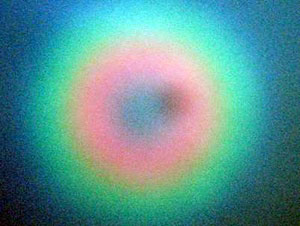| Mar 30, 2011 |
Quantum physics: A degree of entanglement
|
|
(Nanowerk News) Entanglement is one of the most bizarre implications of quantum mechanics. It acts like an invisible link between two distant quantum bodies so that whatever happens to one instantaneously affects the other. Experimentally, this phenomenon has already been verified and studied using light. A relatively simple technique known as spontaneous parametric down conversion (SPDC) can produce photons that are connected in this unusual way, and the method is now used in many laboratories throughout the world.
|
|
Dmitry Kalashnikov and Leonid Krivitsky at the A*STAR Data Storage Institute have now shown that small differences in the properties of these two photons can affect the degree of entanglement, and that the effect can be put to good use ("Spectrally resolved quantum tomography of polarization-entangled states").
|
 |
| Light from a nonlinear crystal is emitted over a range of emission angles (as indicated by the concentric circles) and energies (as indicated by the different colors) with various levels of quantum entanglement.
|
|
When a material with nonlinear optical properties absorbs an incoming photon, it emits two new photons of lower energies. Although these two photons travel in different directions, they remain entangled, meaning that the polarization of one photon is linked to the polarization of the other. "In reality," explains Kalashnikov, "the angle of emission and the energy of each photon can vary within a small band called the SPDC linewidth." This linewidth makes it difficult to observe the polarization entanglement of the photon pair.
|
|
Kalashnikov and Krivitsky have now thoroughly investigated how the quantum state of photons emitted at different angles and energies within the linewidth are connected. They shot a continuous beam of laser light at a bulk crystal of beta-barium borate, and detected the photon pairs produced (see image) using two single-photon counters. One counter scanned and measured light at different emission angles, while the other counter detected light after it had passed through a spectrometer that selected photons with a specific energy. This experiment was repeated for various choices of emission angle and energy to get a full map of the polarization state of the photon pairs using a procedure referred to as quantum tomography.
|
|
"We found that the generated polarization-entangled states are highly specific to the choice of energy and emission angle," says Kalashnikov. "Thus, it is possible to obtain a wide range of polarization-entangled states using just a single nonlinear crystal. The generated states can be efficiently tailored to fit specific applications by placing a specially designed sample of quartz just after the beta-barium borate."
|
|
Based on their results, the researchers hope to investigate highly entangled photon states further with the aim of implementing them in quantum information science.
|

